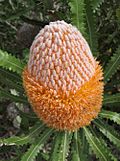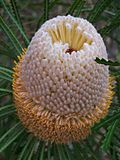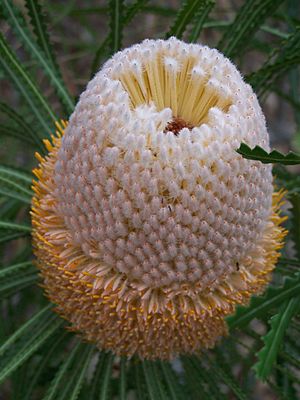Banksia ser. Crocinae facts for kids
Quick facts for kids Banksia ser. Crocinae |
|
|---|---|
 |
|
| Banksia prionotes, the type species of B. ser. Crocinae | |
| Scientific classification | |
| Kingdom: | |
| (unranked): | |
| (unranked): | |
| Order: | |
| Family: | |
| Genus: | |
| Subgenus: | |
| Section: | |
| Series: |
Banksia ser. Crocinae
A.S.George
|
| Species | |
Banksia ser. Crocinae is a special group of four types of Banksia plants. In science, a "series" is a way to group plants that are very similar. This group was first named by a scientist named Alex George in 1981. Later, two other scientists, Kevin Thiele and Pauline Ladiges, changed how they grouped these plants in 1996. But then, Alex George put the group back together in 1999. Scientists use special studies, like looking at plant "family trees" (called cladistics), to figure out how plants are related. These studies show that the Crocinae group is a very natural and closely related family of plants.
Contents
Species in the Crocinae Group
This group includes four types of Banksia plants. All of them grow only in Western Australia. They are:
| Image | Plant | Scientific name | Common name | Where it grows |
|---|---|---|---|---|
 |
 |
B. prionotes | Acorn Banksia | Along the west coast of Western Australia, from Shark Bay in the north to Kojonup and Jerramungup. |
 |
B. burdettii | Burdett's Banksia | Between Eneabba and Mogumber in Western Australia. | |
 |
B. hookeriana | Hooker's Banksia | Between Arrowsmith and Eneabba. | |
 |
 |
B. victoriae | Woolly Orange Banksia | Between Northampton and Kalbarri in Western Australia. |
How Scientists Group These Plants
Scientists use different ways to group plants, like looking at their features or their DNA. This helps them understand how different plants are related, like building a family tree.
Alex George's Idea in 1981
In 1981, Alex George wrote an important book about Banksia plants. He put the four Crocinae species into their own group because they looked very similar, especially their flowers. He named the group Crocinae because "crocinus" is Latin for "rich orange," which describes their bright orange flowers. He also thought this group might have come from another Banksia group called Orthostylis.
Here's a simplified look at how George grouped Banksia plants in 1981, showing where Crocinae fit in:
- Banksia (The main group of all Banksia plants)
- B. subg. Banksia (A large subgroup)
- B. sect. Banksia (A section within the subgroup)
- B. ser. Crocinae (Our special group)
- And many other Banksia series groups.
- B. sect. Banksia (A section within the subgroup)
- B. subg. Banksia (A large subgroup)
Thiele and Ladiges' Idea in 1996
In 1996, Kevin Thiele and Pauline Ladiges studied Banksia plants using a method called cladistics. This method helps scientists draw "family trees" (called cladograms) based on how plants look. Their studies showed that the Crocinae group was indeed a natural family. However, another group, B. ser. Banksia, was not a natural family because it didn't include all its descendants.
Because of this, Thiele and Ladiges decided to get rid of the Crocinae group. They moved its four species into the B. ser. Banksia group. They then divided B. ser. Banksia into smaller subgroups, and the Crocinae species ended up in a subgroup called B. subser. Cratistylis.
Here's a simplified family tree from their study, showing how the Crocinae species are related:
|
|
|||||||||||||||||||||||||||||||||||||||||||||||||
|
|||||||||||||||||||||||||||||||||||||||||||||||||
Alex George's Idea in 1999
Thiele and Ladiges' new grouping didn't last long. In 1999, Alex George published another important work for the Flora of Australia series. He mostly went back to his original 1981 grouping. For the Crocinae group, his 1999 arrangement was almost the same as his 1981 one, except he swapped the order of B. burdettii and B. victoriae.
New Discoveries
Since 1998, a scientist named Austin Mast has been studying the DNA of Banksia plants. DNA is like a plant's instruction manual, and studying it can show how plants are related. His studies suggest a family tree that is different from the earlier ideas. He found that the Crocinae group is still a natural family, or very close to it. This group is closely related to B. menziesii. This larger group is then related to other Banksia species like B. sceptrum and B. ashbyi.
Here's a simplified family tree from recent DNA studies:
|
|||||||||||||||||||
|
|
|||||||||||||||||||
In 2007, Mast and Thiele started to rearrange the Banksia genus again. They moved another group of plants called Dryandra into Banksia. They also created a new subgroup called B. subg. Spathulatae for plants with spoon-shaped first leaves (called cotyledons). All the plants in the Crocinae group belong to Mast and Thiele's B. subg. Banksia. Scientists are still working on a full new arrangement as they finish studying the DNA of all the Dryandra plants.
See also
 In Spanish: Banksia ser. Crocinae para niños
In Spanish: Banksia ser. Crocinae para niños



